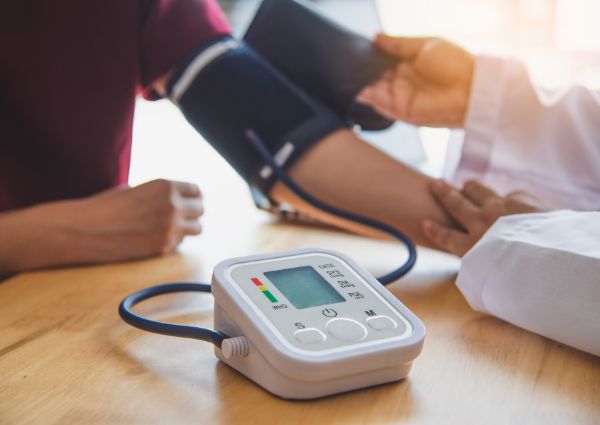The Benefits of the ABPM Examination for Accurate Blood Pressure Analysis
Ambulatory Blood Pressure Monitoring (ABPM) uses an advanced approach to evaluating high blood pressure. This technique supplies constant, 24-hour data, catching changes that take place during everyday tasks and sleep. Such comprehensive monitoring not just improves precision but additionally discloses crucial patterns, assisting to compare true hypertension and conditions like white-coat disorder. Understanding these nuances might lead to more reliable treatment methods. What implications might this have for individual care and management?
What Is Ambulatory Blood Pressure Monitoring (ABPM)?
Ambulatory Blood Pressure Monitoring (ABPM) is an approach that permits constant blood stress assessment over a 24-hour duration, providing a comprehensive image of a person's high blood pressure fluctuations. ABPM test in Bangalore. This method makes use of a portable device that immediately measures blood stress at routine periods throughout the day and evening. As people deal with their day-to-day activities, the device captures data showing their blood stress variants throughout different times and conditions, including sleep and physical exertion.ABPM is particularly useful for diagnosing problems such as hypertension, as it can differentiate in between true high blood pressure and white-coat syndrome, where clients exhibit elevated analyses in professional setups but not in their daily lives. By supplying a comprehensive view of blood pressure modifications, ABPM aids doctor in making informed choices regarding medical diagnosis and therapy. It improves the understanding of blood pressure patterns, making it possible for personalized administration methods for patients.
Continuous Monitoring for Improved Precision
Continuous monitoring of high blood pressure with ABPM considerably enhances the accuracy of analyses contrasted to typical techniques. This technique permits blood pressure measurements at routine intervals throughout the day and evening, catching changes that might occur due to day-to-day activities, anxiety, or other elements. Unlike solitary readings taken during a clinic see, ABPM supplies a comprehensive account of a patient's blood pressure over a 24-hour period.This continual analysis causes extra trustworthy data, making it possible for doctor to recognize patterns and potential concerns that may go unnoticed with erratic measurements. It likewise helps identify between true hypertension and white-coat disorder, where individuals display raised analyses due to stress and anxiety in a scientific setting. By leveraging the benefits of continual monitoring, ABPM significantly boosts medical diagnosis and therapy techniques, inevitably adding to far better individual results and more individualized health care strategies.
Recognizing Blood Pressure Irregularity
Blood pressure irregularity refers to the fluctuations in high blood pressure readings that can take place in time because of various aspects, consisting of exercise, anxiety, and body clocks. This irregularity is significant as it supplies understandings right into an individual's cardiovascular wellness. ABPM test in Bangalore. Aspects such as exercise can momentarily increase blood stress, while relaxation may lead to a decrease. In addition, the body's natural rhythms can trigger blood stress to differ throughout the day, typically being reduced during the night and higher during waking hours. High levels of variability have been connected with enhanced dangers of cardiovascular occasions, making it essential for health care specialists to keep an eye on these changes. Understanding high blood pressure irregularity helps in customizing treatment strategies and assessing total wellness. Accurate evaluation with techniques like Ambulatory Blood Stress Monitoring (ABPM) can record these variations, enabling an extra complete evaluation of a person's high blood pressure account
Identifying White Coat Hypertension
White coat high blood pressure, typically described as white layer disorder, is characterized by elevated blood stress analyses in scientific settings because of anxiousness or anxiety. Acknowledging its signs and symptoms and signs is important for precise medical diagnosis, as misinterpretation can lead to unneeded therapies. Understanding this phenomenon is vital for effective high blood pressure monitoring and client treatment.
Recognizing White Coat Syndrome
Although lots of people exhibit elevated high blood pressure analyses in professional setups, this sensation, known as white layer high blood pressure, can obscure truth state of their cardiovascular wellness. This problem happens when people experience stress and anxiety or tension during clinical gos to, causing temporary spikes in blood pressure. Because of this, healthcare suppliers might misinterpret these readings as a sign of high blood pressure. White layer disorder highlights the significance of exact blood pressure assessment, as depending only on in-office dimensions can lead to unneeded treatments or misconceptions regarding a patient's health. Comprehending this disorder is essential for clinicians, as it highlights the demand for alternative monitoring techniques, such as ambulatory blood pressure monitoring (ABPM), to obtain an extra exact representation of a client's high blood pressure degrees.
Symptoms and Indicators
Lots of people might experience details symptoms that suggest the existence of white layer hypertension. These signs and symptoms can consist of raised blood pressure analyses throughout medical visits, gone along with by feelings of stress and anxiety or nervousness in a clinical atmosphere. Patients frequently report a quick heartbeat or sweating when communicating with medical care experts, which may aggravate their high blood pressure degrees. Furthermore, some individuals might discover a variation in between their in-office high blood pressure readings and those taken at home, where they really feel more unwinded. Acknowledging these signs and symptoms is crucial, as they can suggest that stress or stress and anxiety associated to clinical setups is affecting their high blood pressure. Comprehending these signs can assist in identifying white coat high blood pressure and establishing the requirement for more assessment.

Value of Accurate Medical Diagnosis
Properly identifying white coat hypertension is crucial for effective high blood pressure administration. This problem takes place when a person exhibits elevated high blood pressure analyses in a scientific setup because of anxiousness or anxiety, while normal analyses are videotaped in a more relaxed atmosphere. Misdiagnosis can result in unnecessary therapy, subjecting individuals to prospective medication adverse effects without any kind of real health and wellness the original source benefit. Using ambulatory blood stress monitoring (ABPM) is necessary in differentiating real high blood pressure from white layer syndrome. ABPM offers continual check that high blood pressure dimensions over 24 hours, permitting for a comprehensive analysis that can help doctor make educated decisions. Ultimately, exact identification of white coat high blood pressure warranties patients receive ideal care and stays clear of the risks of mismanagement.
Evaluating Nocturnal Blood Pressure Patterns
Evaluating nighttime blood stress patterns is important for understanding an individual's general cardiovascular wellness. Nighttime dimensions can expose significant variations in high blood pressure, which may suggest hypertension irregularity. In addition, these patterns are very closely associated with heart health and wellness, highlighting the importance of constant monitoring beyond standard office gos to.
Value of Evening Measurements

Nighttime blood stress measurements are often vital for recognizing an individual's overall cardiovascular health and wellness. These readings give essential insights right into just how blood stress behaves throughout rest, which can differ substantially from daytime levels. Keeping track of nocturnal blood pressure enables the recognition of abnormal patterns, such as non-dipping or reverse-dipping phenomena, which may indicate an increased threat for cardiovascular occasions. In addition, nighttime assessments can assist examine the efficiency of antihypertensive treatments, ensuring that medicines are appropriately managed. By catching blood stress changes during the evening, health care professionals can develop extra personalized therapy plans, inevitably improving client results and minimizing the possibility of long-lasting difficulties associated with high blood pressure. This highlights the relevance of complete high blood pressure analysis throughout the day and evening.
Identifying High Blood Pressure Variability
Just how can the irregularity of nighttime blood pressure patterns educate high blood pressure management? The assessment of nocturnal high blood pressure through the Ambulatory Blood Pressure Monitoring (ABPM) test exposes vital fluctuations that frequently go unnoticed in conventional measurements. These patterns can indicate the existence of "non-dipping" hypertension, where high blood pressure stops working to drop during sleep, recommending a raised cardiovascular risk. By recognizing such irregularity, healthcare providers can customize treatments better, adjusting treatment strategies based upon the individual's details nocturnal blood pressure actions. Recognizing these patterns additionally help in evaluating the efficiency of antihypertensive drugs, making sure that people accomplish excellent blood stress read control throughout the night and day. As a result, nocturnal evaluation ends up being important in complete hypertension management.
Connection With Heart Health
Comprehending nighttime high blood pressure patterns not just help in hypertension administration but additionally has considerable ramifications for heart health and wellness. Research study shows that uncommon nocturnal blood pressure readings, such as non-dipping or reverse dipping patterns, are connected with increased cardiovascular threats. During sleep, high blood pressure normally declines, a phenomenon crucial for cardio recovery. When this decrease is missing, it might indicate underlying problems such as free disorder or enhanced arterial rigidity. In addition, people with elevated nighttime blood stress go to a heightened threat for cardiovascular disease and stroke. Utilizing ambulatory blood pressure monitoring (ABPM) to assess these nocturnal patterns can supply necessary understandings, permitting for tailored interventions that much better shield heart health and boost overall patient end results.
Customizing Therapy Plans Based Upon Real-Life Data
Customizing therapy strategies based on real-life data involves leveraging continuous blood stress keeping an eye on to develop customized health care approaches. The Ambulatory Blood Pressure Monitoring (ABPM) examination gives a comprehensive account of an individual's blood stress variants throughout day-to-day tasks. This comprehensive data allows doctor to recognize patterns that may be neglected in typical workplace visits.By examining variations in high blood pressure during different times and conditions, medical professionals can readjust drugs, does, and way of life referrals to better fit specific client requirements. This customized technique not just improves the efficiency of treatment plans but also reduces the probability of unfavorable reactions to medications.Furthermore, real-life information can reveal prospective triggers for hypertension, bring about aggressive treatments. On the whole, customizing treatment based on constant monitoring promotes a more reliable, patient-centered approach to handling high blood pressure and improving long-lasting health outcomes.
Boosted Individual Conformity and Involvement
While typical monitoring approaches might limit person involvement, using Ambulatory High blood pressure Monitoring (ABPM) greatly boosts individual conformity and engagement in their own health care. By allowing clients to use a portable device that tapes blood stress over 1 day, ABPM equips individuals to take an active function in their health and wellness monitoring. This constant monitoring supplies a much more complete view of high blood pressure variations, encouraging patients to comprehend their problem better.Moreover, ABPM promotes a setting where people can review their readings with medical care companies much more meaningfully, bring about educated decision-making. Individuals come to be extra invested in adhering to recommended treatments and lifestyle adjustments when they see real-time data mirroring their health condition. Subsequently, the change from easy participant to active partner not only improves compliance yet additionally enhances total wellness results, making ABPM an important device in cultivating patient involvement in hypertension management.
Often Asked Questions
For how long Does an ABPM Examination Commonly Last?
The ABPM test usually lasts 1 day. During this period, it gauges high blood pressure at routine intervals, offering a thorough assessment of a person's high blood pressure patterns throughout their daily tasks and rest.
Exist Any Kind Of Threats Connected With ABPM Testing?

Can ABPM Be Utilized for Youngsters and Teens?
ABPM can be utilized for children and adolescents, offering important insights right into their high blood pressure patterns. Appropriate tools sizing and analysis by skilled specialists are crucial to ensure exact evaluations and avoid misdiagnosis.
Just How Is ABPM Different From Conventional Blood Pressure Monitoring?
ABPM differs from traditional monitoring by giving continuous blood stress analyses over 24 hr, capturing variations throughout day-to-day activities and rest, whereas traditional techniques often count on solitary dimensions, potentially missing out on vital changes in blood stress.
What Should Individuals Do Throughout the ABPM Examination?
During the ABPM examination, people must preserve regular tasks while avoiding hefty exercise, excessive caffeine, and smoking cigarettes. They must additionally keep their arm still when the device inflates, ensuring accurate readings throughout the monitoring duration.